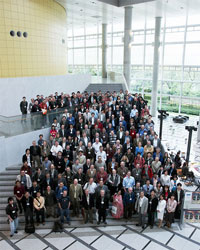 |
 |
|||||||||||||
|
|||||||||||||
|
|||||||||||||
|
Reviewing a year that is coming to an end can be a bit like time travel. While some events seem like they happened only yesterday others seem so long ago that it is hard to believe they happened only a few months ago. Here are some events and developments that were not only important this year but also put the ILC project on a status timeline. The detector community is no doubt pleased that the long meetings, nights of running simulation jobs and creative writing – all needed to produce the Letter of Intent (LOI) for the three ILC detector concepts – were over on 31 March this year, the deadline for LOI submission. Nightshifts then started for the International Detector Advisory Group (IDAG): within a few weeks they had read through the three proposals and bombarded the concept groups with more questions. On 17 August IDAG presented its conclusions: both the ILD and the SiD detector concepts were validated. They can now enter into their next phase – preparing technical design studies in 2012, at the same time as the ILC machine. “Building on many years of R&D and design studies, the community has designed two complementary approaches to the physics of the ILC. Much hard work remains, but this was a significant milestone,” says Jim Brau, co–chair of the Worldwide Study and regional detector contact for the Americas. 2009 did not only have a lively – but mostly sunny – review season, it was also the year in which experts went back to the drawing board, reconsidered some of the machine design decisions made for the Reference Design Report in 2007 and worked on a couple of new proposals, all bearing interesting names — 'minimum machine', AD&I (for accelerator design and integration) or, most recently, Strawman Baseline 2009. Read this week's Director's Corner by Peter Garbincius to learn more about some of the possible changes that could lead to improved design, improved cost estimate, while keeping the physics scope of the ILC machine. The proposal will be reviewed early next year, the Global Design Effort expects decisions on changes at the ICHEP2010 meeting in Paris next summer, leading to the publication of the Technical Design Report (TDR) at the end of 2012.
No man is an island, and neither is the ILC: the project is very much embedded into the science policies of the different regions and countries of the 2000 people working on it. It waits for its slot in the world of particle physics: results from the Large Hadron Collider, now breaking energy records at CERN, will play a vital role in determining the future of the field. Two projects therefore moved even closer together, created task teams and exchange experts for their respective steering committees: ILC and the Compact Linear Collider (CLIC) Study. Two future electron–positron colliders at different R&D stages, they still have many areas in common, and a workshop this year and a planned one next year underline this. Brian Foster, European Regional Director, considers the deepening collaboration with CLIC one of the most important developments of this year: “It particularly affected me because I joined the CLIC Steering Committee, which has been a most interesting and illuminating experience.” There were some good funding news and some bad – Americas Regional Director Mike Harrison is pleased that “after the debacle of US funding in 2008, we achieved agreement with the Department of Energy for funding support for the TDR phase for the period of 2009 through 2012,” whereas Japan saw an assignment of a major amount of supplementary budget for linear collider efforts in Japan in April by one government, and its revocation in October by another government – KEK scientist Nobu Toge's lesson from this: “we had better prepare a multiple set of development strategies with varying timescales and scoping, which allow us to switch from one to another, so that we can more smoothly handle a situation like this.” There were some interesting articles in the press (see for example this one) and the ILC NewsLine team published the 200th issue, along with a survey, and a few special issues on detectors, electron clouds and technology transfer. The community met in Tsukuba, Japan and Albuquerque, US, in the FLASH control room a team studied what was the closest demonstration of a working ILC so far, test facilities in the US and in Japan made big steps forward and the very first cryomodule reached more than 32 Megavolts per metre for its acceleration gradient. In the world around us, the LHC started up again, DESY celebrated its 50th anniversary, construction for the European X–Ray Free–Electron laser started, a symposium looked at the future of accelerators in America, and Barack Obama is president of the United States. Now which of these events seem like time travel to you? The ILC NewsLine team takes a two–week break and will be back on 7 January 2010. We wish all our readers happy holidays and a successful and exciting 2010. -- The ILC NewsLine team |
|||||||||||||
| © International Linear Collider |

